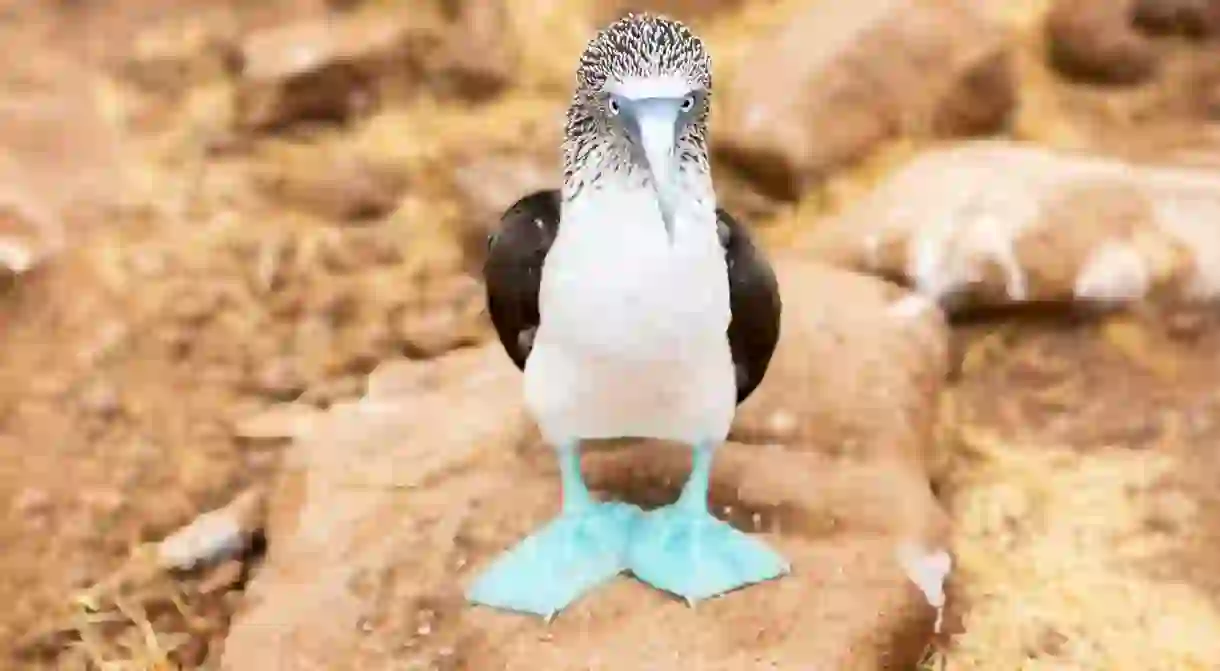The Best Birdwatching Spots in Ecuador

With more than 1,600 species of birds, Ecuador is a birdwatcher’s paradise. Each of the country’s four geographic regions – the Amazon Basin, the Andes, the Pacific Coast and the Galapagos – offer unique opportunities for seeing endemic and hard-to-find species, all while maximizing your final tally. Grab your bird list and start planning your next trip.
Want to get fast-tracked to the best wildlife watching spots in Ecuador? Join our small-group adventure to be led through the country and areas of natural beauty by our Local Insider, seeing all kinds of tropical birds and rare animals along the way.
The Amazon Basin
The water coming off the East Slope of the Andes eventually feeds the mighty Amazon River. This region is rich with cloud forests and sub-tropical jungles.
Cosanga
This region only recently started participating in the annual Audobon Christmas bird count but initial counts hold great promise for the area. In 2018, a team of bird counters identified more than 500 species in a single day. The eastern slope cloud forests are rich with diversity and the rainy season is great for seeing migrating species that visit on an almost daily basis.
Yasuni National Park
Birdwatching in the sub-tropical jungles of the Yasuni National Park can be complicated. Birds don’t like to approach humans for fear of being hunted and many sightings are from a wobbly seat in a canoe. That said, many species can only be seen out in this wild national park. The highlight of any trip into Yasuni is a visit to the parrot clay licks.

Tena
Birdwatching is a popular activity in Tena, gateway to the Amazon rainforest and included in Culture Trip’s eight-day itinerary through Ecuador. Day trips out on the river or walking in local secondary forests can quickly tally up many bird species. If you want to see the beautiful and prehistoric-looking Hoatzin, make sure to visit the Laguna Paikawe.

The Andes
The Andes run the spine of Ecuador from north to south – the high-altitude mountains are extreme habitats that are alternately baked in the equatorial sunlight and then covered in low-lying clouds and mist. The region is home to many different species of birds.
The Northern Andes Near Quito
These high mountains are home to many iconic species – like the tiny but colorful Ecuadorian Hillstar Hummingbird and the marsh-loving Andean Ibis. A favorite is the Sword-Billed Hummingbird which usually shows up in lodges near Quito. The must-see highlight species is the Andean Condor which can be visited at the Jocotoco Foundation’s Antisanilla Reserve in Northern Ecuador.
For more info, check out our dedicated article on birdwatching in and around Quito.

The Southern Andes Near Loja
The region near Loja is not visited by birdwatchers as often as they visit regions further north. One good reason to add this area to your list is that the high Andes and the lower-lying jungles are easy to visit in a single trip. The area is not heavily developed for international tourism, but a few local lodges provide good quality accommodation. For hummingbirds in the higher altitudes, check out the Utuana Reserve and for jewel-toned tanagers in the sub-tropical jungles, Copalinga makes an excellent choice.

The Pacific Coast
The water coming off the Andes on the West Slope heads to the Pacific Coast – this region holds some of the most diverse but endangered habitats in South America.
Tandayapa Valley
The cloud forests of Tandayapa are less visited than the more famous birding reserves around Mindo but have many of the same iconic species. Visit while the trees are fruiting to have the best chance of photographing the Plate-Billed Mountain-Toucan.

Milpe
One of the best access points to birdwatching in the sub-tropical forests along the Choco Corridor – a biodiversity hotspot that runs through Ecuador from Colombia into northern Peru – is near the small community of Milpe. Brightly colored species, like the Chestnut Mandible Toucan, the Pale Mandibled Aracari and the Crimson-rumped Toucanet all call Milpe home.
Parque Nacional Machalilla
The only national park on the Pacific Coast of Ecuador is Parque Nacional Machalilla. The land at Agua Blanca is a dry coastal forest – an endangered habitat with a surprising number of bird species, like the Whooping Momot and the Peruvian Screech Owl. Isla de la Plata – another part of the park – is home to nesting Blue-Footed and Red-Footed Boobies and two species of Frigate Birds. In addition, many of the beaches in the region attract other water-loving birds.
The Galápagos Islands
Although birds can be seen on every single island in the Galápagos Islands, some locations are easier than others to see a certain species.
Isla San Cristobal
San Cristobal Island is the best location for spotting all three species of Boobies: the Blue-Footed, the Red-Footed and the Nazca Booby. Make sure to book a trip that includes hiking out to the far side of the island to Punta Pitt – or save yourself the hassle and let us handle all the details for you by joining our five-day Galápagos adventure.
Isla Isabela
If you want to see the Galápagos Penguin, Isla Isabela provides the best opportunities. The birds nest near Puerto Villamil and often swim past incoming boats. A day trip to Las Tintoreras provides an up-close-and-personal visit to sunbathing and swimming penguins.

Isla Española
Isla Española is the sole nesting site of the entire world population of the Waved Albatross – the breeding colony is estimated at 25,000 to 30,000 birds. The mating dance of the Waved Albatross can last up to five days and takes place early in April, while the first flight can be observed in December before the birds head out on a three-month fishing trip.














